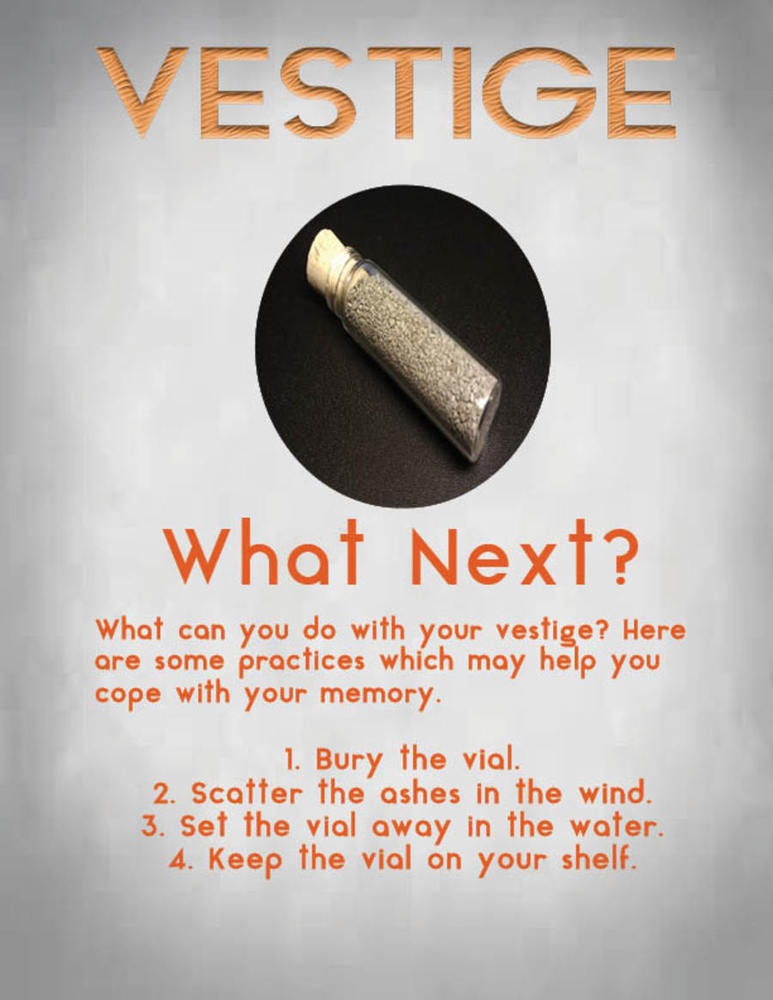Design Decisions
Vestige exists in an interesting space between the user doing the work and letting the machine do the work. In our research, we found that people were more likely to remember an emotional event if they were involved in the process. Vestige does limit user input to choosing what they want to delete, and then requiring an affirmative gesture, in our case swiping the photo towards the kiosk. However, there was a counter-point in that people found it more comforting that they weren't actually the ones destroying the images. By limiting the user's participation, Vestige is not as hostile and is more approachable, as it will do the tough parts for them.
One question we had to consider was "Where does Vestige exist in the real world?" Would it be placed in the public world, or was it something that should exist in the private world on one's desk or home? Ultimately, we decided that Vestige would exist in a public place and act like a kiosk, similarly to photo booths or ATMs in supermarkets. Our group believed that the act of forgetting should be an intentional one which required a physical call to action to go to a public place. By leaving it in a private area like home, the lack of physical action would be akin to the lack of physical action involved in simply deleting a photo on a phone. While the act of doing something as intimate as burning a photo in public appears uncomfortable, that temporary discomfort may be incomparable to the more permanent pain of remembering a painful memory. Additionally, the device itself has a very specific purpose that's niche enough that it would be hard to justify having one in an individual's home. Plus, the input/output and storage of bottles is more fitting at the scale of a public device, where it can be restocked like a vending machine.
Additionally, we included in our a prompt to introduce the users to Vestige. The purpose of the prompt was to affirm the users that the pain they were experiencing was justified, and comfort them so they could engage in this act of burning a digital photo. We included this because we wanted to prime the users to prepare for such an intimate act of forgetting. This level of intentionality is something photo booths or ATM kiosks lack, and for the purposes of Vestige, we believed this was necessary. Luckily, the proposed system would be easy to use, connecting via Bluetooth and then swiping the items you would want to delete. While some sort of instructions for these would be good to have for a final product, the gist of things can be communicated with a simple message before connecting.
Moreover, with regards to the relation between ash accumulated and the amount of photos deleted, we designed it so the more photos deleted, the greater amount of ash in the vial. If the user had decided to forget many photos, this would help him/her recognize the large amount of emotional baggage that he/she had carried, and hopefully let him/her believe that this amount of physical load was no longer on his/her back.
Finally, at this kiosk, there would be a pamphlet recommending the users what to do with the vial of ash. Similarly to how mental health pamphlets have a list of recommended actions to help cope with problems, this list of recommended practices could facilitate the act of forgetting the painful memory. We listed acts, such as spreading the ashes away in the wind, burying the vial, setting the vial away in the water, or even keeping the vial. Vestige can also store vials internally if users don't want to take them if the memories attached to them are undesirable. In any further iterations of this project, it would be a good idea to inform users about a hotline that they could call if they need someone to talk to. This could be something that the corporate entity behind Vestige could run.

